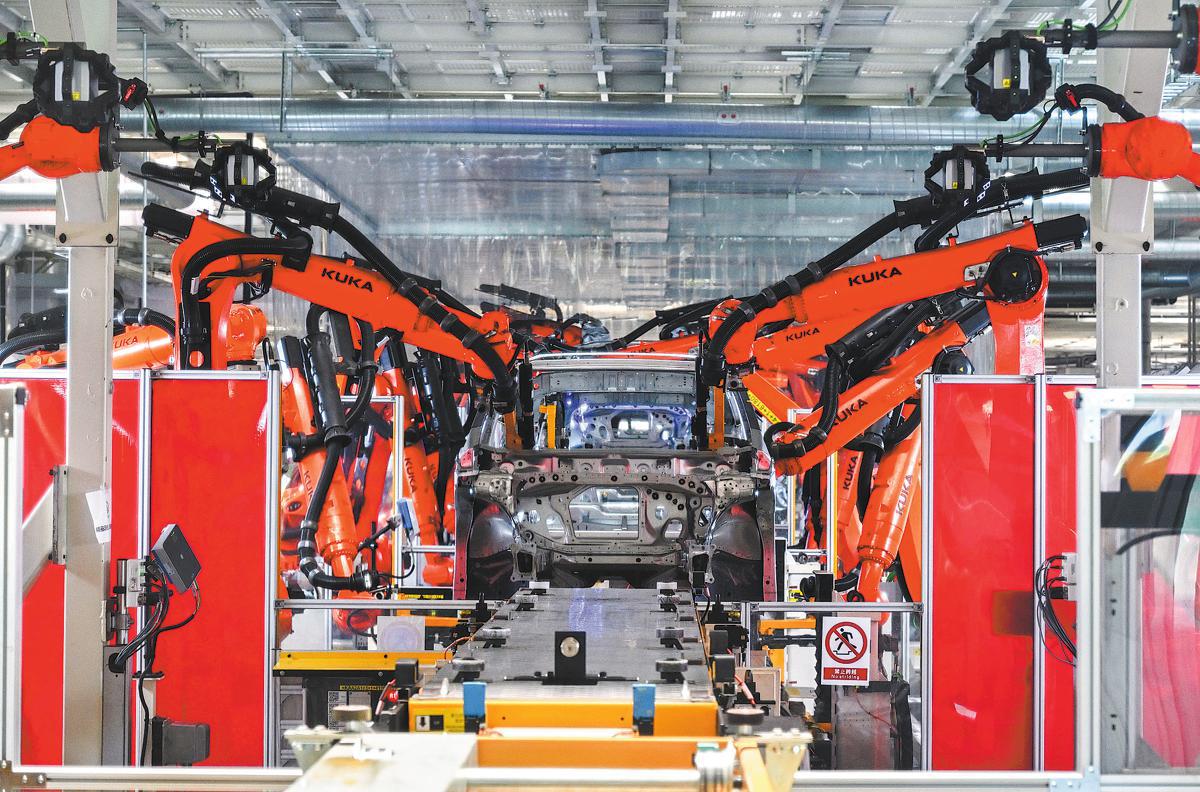Global auto giants look to China for future vision
China Daily2025-06-10 22:09
Once solely a growing market, domestic innovation has turned the car industry on its head

Workers and robotic arms operate at the production line of Volkswagen Anhui, the carmaker's first electric vehicle joint venture in China, in Hefei, Anhui province, on May 21. [Photo provided to CHINA DAILY]
At the Auto Shanghai show in April, an executive of Volkswagen — one of the world's biggest auto manufacturers — made a frank admission that the German giant had misfired on its country strategy for China.
"To be very honest, we didn't have the right product strategy or the right approach to drive the business in China," Oliver Blume, chairman of the board of management of the Volkswagen Group, told China Daily.
He was referring to the situation when the same event was held two years ago.
"But at this auto show, we're not just talking about strategy or plans on paper — we're showcasing real results, and that makes me very proud of what the teams have accomplished," said Blume.
The German automaker's long and profitable association with China began in October 1984 when it inked a deal with the Shanghai Automobile & Tractor Company to begin a joint venture, Shanghai Volkswagen. Now known as SAIC Volkswagen, it is the oldest extant automotive partnership in China.

Workers and robotic arms operate at the production line of Volkswagen Anhui, the carmaker's first electric vehicle joint venture in China, in Hefei, Anhui province, on May 21. [Photo provided to CHINA DAILY]
Despite the Germans' initial concerns that the fledgling China operation could not produce even "one Volkswagen-standard car" the first model of the joint venture, the Santana, rolled off the assembly line in late 1985.
German technology and management, coupled with China's reform and opening-up and local workers' diligence, was the right formula for success. The Santana was a triumph, and for more than 30 years Volkswagen — joined by other foreign automakers such as Peugeot, Fiat, Toyota and Hyundai — rode on the path of prosperity created by China's ongoing development and modernization.
By 2009, China had become the world's largest vehicle market, and non-Chinese brands accounted for 56 percent of total vehicle sales, according to the China Association of Automobile Manufacturers.
But, the peak for overseas auto manufacturers in China was followed by a decline as the industry entered the era of NEVs.
Volkswagen sales tumbled from 3.85 million units in 2020 to 2.92 million units in 2024. In the meantime, Chinese automaker BYD's sales skyrocketed from 427,000 units in 2020 to 4.27 million units in 2024.
Volkswagen wasn't alone. South Korean automaker Hyundai, the world's third-largest carmaker, delivered 507,000 units in China in 2020, but last year its sales shrank to 157,000 units.
General Motors, the No 1 carmaker in the United States, saw its sales in China plunge from 2.9 million units to 1.83 million units over the same period.

Workers assemble a car at the FAW-Volkswagen production base in Qingdao, Shandong province, on April 15.LIANG XIAOPENG/XINHUA
Strategic rethink
In recent years, Volkswagen has come to realize that developing cars in Europe and bringing them into China no longer works, as local rivals are coming up with completely new products at a super fast speed and car buyers are young and tech-savvy.
Ralf Brandstaetter, CEO of Volkswagen Group China, expressed those ideas in late 2023 in Hefei, capital of East China's Anhui province, where the German company has built an R&D facility dedicated to smart new energy vehicles (NEVs).
With an investment of 1 billion euros ($1.09 billion), Volkswagen China Technology Company is the carmaker's largest development center outside Germany. The center is creating an electric vehicle (EV) platform specifically for the Chinese market and to meet the demands of Chinese customers, The first model is scheduled to roll out in 2026.
"We will bring the platform to market maturity in just 36 months. This means that we are reducing the development time by around a third," Brandstaetter said.
One key driver of efficiency is greater involvement of local suppliers. Volkswagen said around 1,100 Chinese suppliers are involved, and the localization rate will gradually be increased to 100 percent.
Volkswagen calls it the second wave of "localization" in the country. In the first wave, the company purchased components from international suppliers' plants in China, which nevertheless required going back and forth with the automaker's headquarters in Germany, a company executive explained.
But now, Volkswagen sources components directly from Chinese companies and involves them in the early stages of development, which saves time and improves integration.
This year's Auto Shanghai show saw several new Volkswagen models — including the ID. AURA, the ID.ERA and the ID. EVO — on display that offered a glimpse into the company's electric vehicle-focused future.
Starting from 2026, over 20 state-of-the-art NEVs will be launched, including battery electric vehicles, plug-in hybrid electric vehicles and extended-range electric vehicles, to suit differing customer demands in China, said the carmaker.
More importantly, these models are not engineered in Germany, but developed with "Chinese solutions", making them more appealing to local customers.
The carmaker launched its "in China for China" strategy in 2023. "For us, 'in China, for China' is not just a slogan — it's our execution mode," Brandstaetter told China Daily at the auto show.
Despite Volkswagen's renewed confidence, the challenges ahead remain formidable and Brandstaetter is acutely aware of the realities, especially the fierce competition faced from Chinese automakers.
While the new generation of Volkswagen models tailored for the Chinese market is just around the corner, Brandstaetter remains cautious. "We are confident, but I think the competition is tough here in China, and this will be an ongoing challenge in the coming year," he said.
